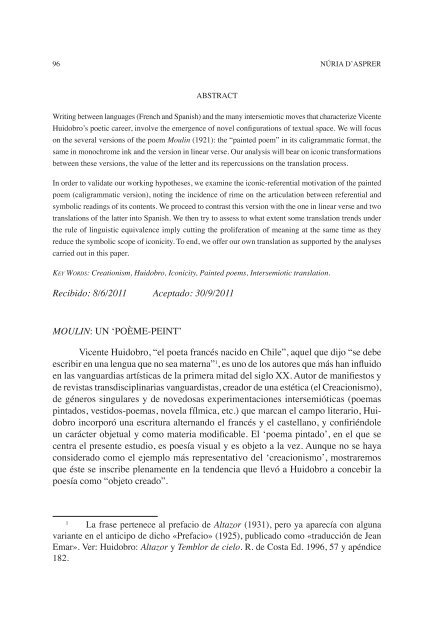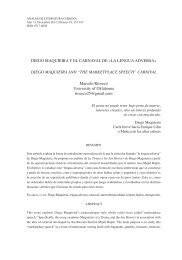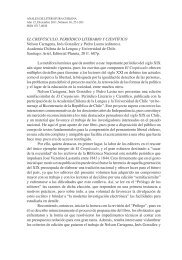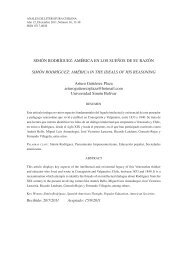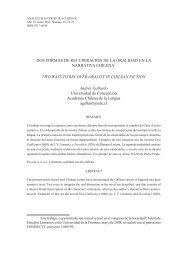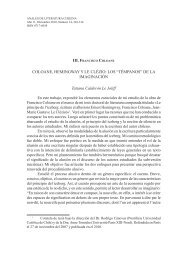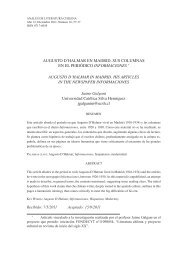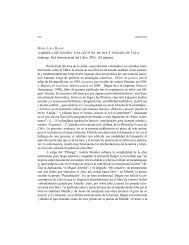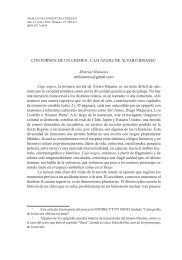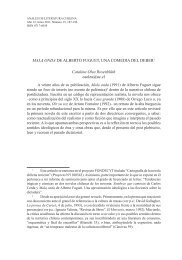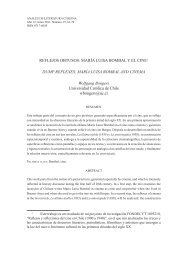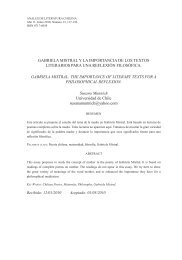LA TRADUCCIÓN COMO DISPOSITIVO 'CREACIONISTA' EN LA ...
LA TRADUCCIÓN COMO DISPOSITIVO 'CREACIONISTA' EN LA ...
LA TRADUCCIÓN COMO DISPOSITIVO 'CREACIONISTA' EN LA ...
Create successful ePaper yourself
Turn your PDF publications into a flip-book with our unique Google optimized e-Paper software.
96 NúRIA D’ASPRER<br />
ABSTRACT<br />
Writing between languages (French and Spanish) and the many intersemiotic moves that characterize Vicente<br />
Huidobro’s poetic career, involve the emergence of novel configurations of textual space. We will focus<br />
on the several versions of the poem Moulin (1921): the “painted poem” in its caligrammatic format, the<br />
same in monochrome ink and the version in linear verse. Our analysis will bear on iconic transformations<br />
between these versions, the value of the letter and its repercussions on the translation process.<br />
In order to validate our working hypotheses, we examine the iconic-referential motivation of the painted<br />
poem (caligrammatic version), noting the incidence of rime on the articulation between referential and<br />
symbolic readings of its contents. We proceed to contrast this version with the one in linear verse and two<br />
translations of the latter into Spanish. We then try to assess to what extent some translation trends under<br />
the rule of linguistic equivalence imply cutting the proliferation of meaning at the same time as they<br />
reduce the symbolic scope of iconicity. To end, we offer our own translation as supported by the analyses<br />
carried out in this paper.<br />
Key Words: Creationism, Huidobro, Iconicity, Painted poems, Intersemiotic translation.<br />
Recibido: 8/6/2011 Aceptado: 30/9/2011<br />
MouLIN: UN ‘POèME-PEINT’<br />
Vicente Huidobro, “el poeta francés nacido en Chile”, aquel que dijo “se debe<br />
escribir en una lengua que no sea materna” 1 , es uno de los autores que más han influido<br />
en las vanguardias artísticas de la primera mitad del siglo XX. Autor de manifiestos y<br />
de revistas transdisciplinarias vanguardistas, creador de una estética (el Creacionismo),<br />
de géneros singulares y de novedosas experimentaciones intersemióticas (poemas<br />
pintados, vestidos-poemas, novela fílmica, etc.) que marcan el campo literario, Huidobro<br />
incorporó una escritura alternando el francés y el castellano, y confiriéndole<br />
un carácter objetual y como materia modificable. El ‘poema pintado’, en el que se<br />
centra el presente estudio, es poesía visual y es objeto a la vez. Aunque no se haya<br />
considerado como el ejemplo más representativo del ‘creacionismo’, mostraremos<br />
que éste se inscribe plenamente en la tendencia que llevó a Huidobro a concebir la<br />
poesía como “objeto creado”.<br />
1 La frase pertenece al prefacio de Altazor (1931), pero ya aparecía con alguna<br />
variante en el anticipo de dicho «Prefacio» (1925), publicado como «traducción de Jean<br />
Emar». Ver: Huidobro: Altazor y temblor de cielo. R. de Costa Ed. 1996, 57 y apéndice<br />
182.


